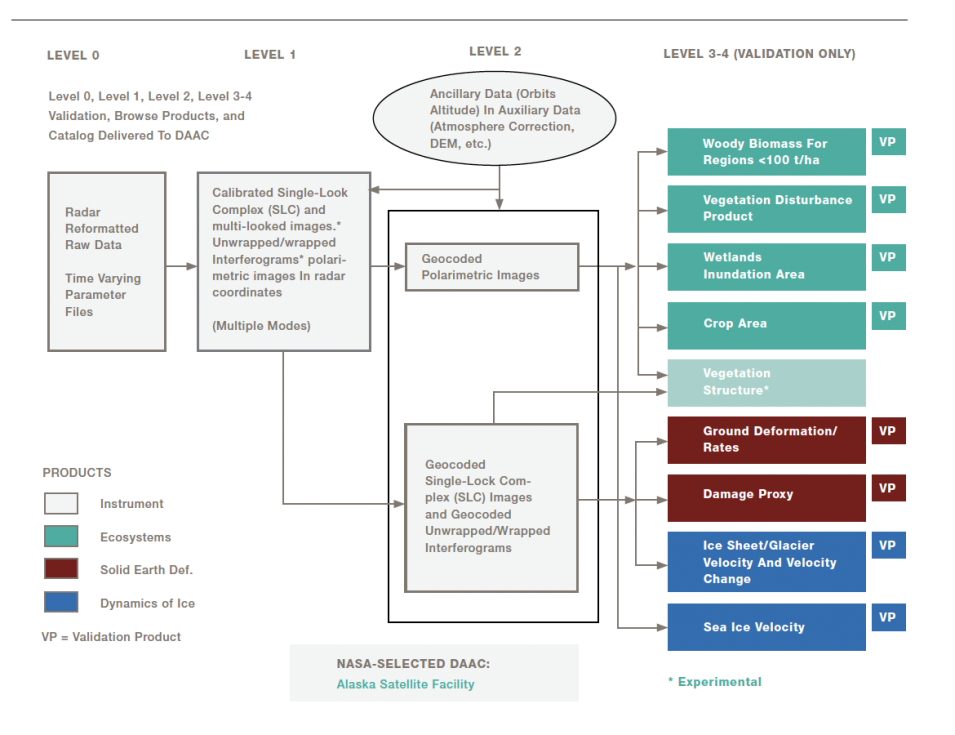| CRID | Composite Release ID | Composite Release ID (CRID) is a unique identifier to provide provenance of the aggregate software and static input file versions listed in generation of a product granule |
| SDS | SDS release | Science Data System (SDS) version used to generate given product. |
| PCM | PCM SW | Processing Control & Data Management Subsystem (PCM) used to orchestrate product generation within a given SDS |
| L0A_L_PGE | PGE SW | Product Generation Executable (PGE) version of L0A_L_PGE |
| L0A_CC | PGE SW | Product Generation Executable (PGE) version of L0A_CC |
| L0A_TE | PGE SW | Product Generation Executable (PGE) version of L0A_TE |
| L0A_CC_TE | PGE SW | Product Generation Executable (PGE) version of L0A_CC_TE |
| LSAR_Time_Extractor | PGE SW | Product Generation Executable (PGE) version of LSAR_Time_Extractor |
| L0B_L_PGE | PGE SW | Product Generation Executable (PGE) version of L0B_L_PGE |
| RSLC_L_PGE (l1_l2) | PGE SW | Product Generation Executable (PGE) version of RSLC_L_PGE |
| GSLC_L_PGE (l1_l2) | PGE SW | Product Generation Executable (PGE) version of GSLC_L_PGE |
| L2_L_GCOV (l1_l2) | PGE SW | Product Generation Executable (PGE) version of L2_LGCOV |
| InSAR_L_PGE (l1_l2) | PGE SW | Product Generation Executable (PGE) version of L2_InSAR_L_PGE |
| L3_L_SME2_PGE | PGE SW | Product Generation Executable (PGE) version of L3_L_SME2_PGE |
| DC_RADAR_PGE | PGE SW | Product Generation Executable (PGE) version of DC_RADAR_PGE |
| ISCE3 (l0b) | ISCE3 SW | Algorithm version in l0b pge |
| ISCE3 (l1_l2) | ISCE3 SW | Algorithm version in l1_l2 pges |
| ISCE3 (SME2) | ISCE3 SW | Algorithm version in SME2_pge |
| ISCE3 (DC_RADAR) | ISCE3 SW | Algorithm version in DC_RADAR_pge |
| L0A_L_RRST | Product Version | Product version of generated L0A_L_RRST product |
| L0B_L_RRSD | Product Version | Product version of generated L0B_L_RRSD product |
| L1_L_RSLC | Product Version | Product version of generated L1_L_RSLC product |
| L2_L_GSLC | Product Version | Product version of generated L2_L_GSLC product |
| L2_L_GCOV | Product Version | Product version of generarted L2_L_GCOV product |
| L1_L_RIFG | Product Version | Product version of generated L1_L_RIFG product |
| L1_L_RUNW | Product Version | Product version of generated L1_L_RUNW product |
| L1_L_ROFF | Product Version | Product version of generated L1_L_ROFF product |
| L2_L_GOFF | Product Version | Product version of generated L2_L_GOFF product |
| L2_L_GUNW | Product Version | Product version of generated L2_L_GUNW product |
| DC_RADAR | Product Version | Product version of generated DC_RADAR product |
| L3_L_SME2 | Product Version | Product version of generated L3_L_SME2 product |
| PRODUCT_VERSION | Static File | PRODUCT_VERSION file used by SDS to lookup Product Version for a given CRID and PGE, which is then populated in metadata of the product |
| LSAR Parameter Set | Static File | LSAR Parameter Set used by SDS to help populate runconfigs at runtime for a given product by specifying processing parameters for a PGE |
| DEM | Static File | Digital Elevation Model (DEM) file set is digital representation of terrain elevation for the NASA-ISRO NISAR mission used by RSLC_L_PGE, GSLC_LPGE, L2_L_GCOV, InSAR_L_PGE, and DC_RADAR_PGE.
- EPSG 4326 is based on the Copernicus DEM 30-m (2023_1).
- EPSG 3413 is based on the Copernicus DEM 30-m (2023_1), referenced to the WGS84 ellipsoid and projected over the NSIDC Sea Ice Polar Stereographic North coordinate system.
- EPSG 3031 is based on the Copernicus DEM 30-m (2023_1), referenced to the WGS84 ellipsoid and projected over the Antarctic Polar Stereographic coordinate system. |
| LIA | Static File | Local Incidence Angle (LIA) version set used by the SDS to generate SME2 products. A copy of this LIA data is embedded in the L2_L_STATIC set for convenience for users to find all static layers in one location. |
| Water Mask | Static File | Water Mask version set used by the SDS to generate RUNW/GUNW products. A copy of this water mask data is embedded in the L2_L_STATIC set for convenience for users to find all static layers in one location. |
| VWC | Static File | Vegetation Water Content (VWC) version set used by the SDS to generate SME2 products. |
| L2_L_STATIC | Static File | L2_L_STATIC version used to provide static layer content matching the geographical area of a product in a single convenient .h5 file for the user. Static layer content includes:
- digitalElevationModel
- layoverShadowMask
- localIncidenceAngle
- losUnitVectorX
- losUnitVectorY
- projection
- rtcGammaToBetaFactor
- rtcGammaToSigmaFactor
- waterMask |
| TFDB | Static File | TFDB version used by the SDS to generate RSLC products. The TFDB specifies the collection modes of the observations around over the globe, which is delineated by track and frame number in the database. |
| RADAR_MODE_LUT | Static File | RADAR_MODE_LUT version used by PCM to map RCID to Radar Mode short text populated in filename of RSLC product |
| Flight Table Waveform | Static File | Flight Table Waveform version used by L0B_L_PGE |
| Flight Table Parameters | Static File | Flight Table Parameters version used by L0B_L_PGE |
| ANTPAT | Static File | ANTPAT file used by the SDS to generate RSLC_L_PGE and DC_RADAR_PGE products. |
| BFPQ | Static File | ANTPAT file used by the SDS to generate L0B_L_PGE |
| L_CHAN_DATA | Static File | ANTPAT file used by the SDS to generate L0B_L_PGE |
| LSAR_EXT_CAL | Static File | LSAR_EXT_CAL version used by RSLC_L_PGE |
| LSAR_INT_CAL | Static File | LSAR_INT_CAL version used by RSLC_L_PGE |
| TSR_STATIC | Static File | TSR_STATIC used by L3_L_SME2 |
| PMI_STATIC | Static File | PMI_STATIC used by L3_L_SME2 |
| SM_STATIC | Static File | SM_STATIC used by L3_L_SME2 |

